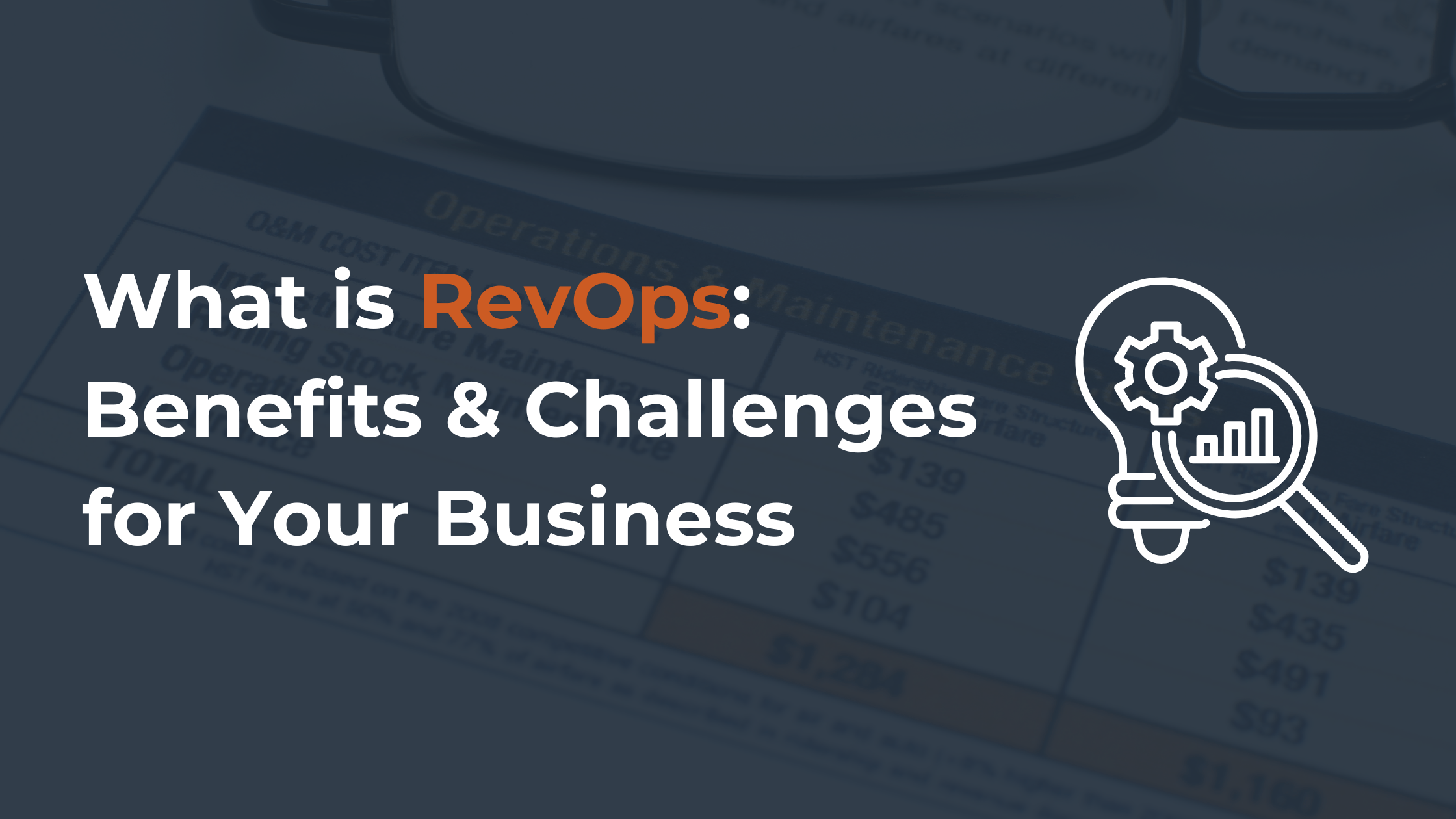What is RevOps?
Revenue operations (RevOps) is the magic formula that aligns sales, marketing, and customer service under one roof to enhance a company’s revenue. It’s like getting the whole squad on the same page, ensuring everyone works towards common goals. Plus, it gives managers a crystal-clear view of how the money’s rolling in.
Why do businesses need revenue operations?
Well, the way B2B companies rake in revenue has evolved. Collaboration between marketing, sales, and customer success is now more critical than ever. Revenue operations take over because, in many B2B firms, all three teams work together to improve the client experience rather than keeping to their own lanes.
They’re all using the same data and tools anyway, so why keep them separate? In most B2B and SaaS firms, the revenue game plan goes like this: Sales leans on marketing to deliver the right leads at the right moment. Meanwhile, the sales team focuses on building long-term, high-value relationships, which has a direct impact on the customer success team.
This alignment naturally leads to shared resources, like tools and even team members, such as SDRs who straddle both marketing and sales at the top of the funnel. RevOps is there to grease the wheels of communication among all revenue-generating teams, roll out new tools, and help smash sales goals.
How does RevOps boost revenue and profitability?
The revenue operations role is to help your business achieve revenue growth and profitability in a variety of ways. They are:
1. Unifying sales, marketing, and customer success
Let's face it—these teams don’t always play nice together, with silos popping up in many companies. RevOps steps in to align everyone, creating a coordinated, cohesive strategy for driving revenue. As a result, less effort is wasted, team communication improves, and everyone works toward the same goals.
2. Data-driven insights
RevOps enjoys delving into data to uncover trends and patterns in consumer behavior. With these insights, your company can uncover new revenue opportunities, fine-tune sales and marketing strategies, and boost customer retention.
3. Process optimization
When processes get better, so does efficiency. RevOps plays an important role here by standardizing training, removing sales funnel obstacles, and automating procedures whenever possible. This not only streamlines procedures but also saves money.
4. Technology enablement
A big part of process optimization is using technology to automate and simplify tasks. RevOps, as the guardian of your company's technology stack, ensures that your teams have the most effective instruments at their fingertips, allowing them to focus on more valuable tasks.
5. Measuring performance
RevOps uses performance indicators and key performance indicators to assess success. By keeping an eye on these metrics, your RevOps team can spot areas that need improvement and take action to fine-tune your processes.
6. Enhancing customer experiences
Every B2B organization strives to provide a consistent and seamless customer experience. A well-oiled RevOps team helps make the buyer’s journey smoother across all touchpoints, leading to higher customer satisfaction and better retention.
Potential issues with revenue operations
What does revenue operations do? It unifies sales, marketing, and customer success operations to enhance efficiency and boost revenue. Implementing revenue operations is definitely worth the effort, but be ready for a bit of a challenge. RevOps needs your company’s full backing and involves some pretty intricate technical stuff. But hey, no one said revolutionizing your revenue strategy would be easy! Just like with any sales process, patience and persistence are your best friends.
First off, you’ve got to invest in top-notch training across the board. Your entire team needs to understand the perks of revenue operations and how they’ll be working within this new system. And don’t skimp on the software—your people need the best tools to really make RevOps shine. No one wants to see a successful RevOps team struggling with subpar tech, right?
Don't think you can simply add a new RevOps department to your existing structure. Some businesses have unclear boundaries between sales and marketing departments, but with RevOps, that line must be crystal clear. The same goes for every other department in your business; everyone needs to know their role and how they contribute to the bigger picture. RevOps helps organizations achieve consistent revenue growth by aligning departments, optimizing resources, and improving decision-making with data-driven insights.
The best practices for adopting a RevOps strategy
What is revenue operations? Revenue operations (RevOps) is a comprehensive approach to optimizing all processes that contribute to revenue growth within a company. Ready to nail your RevOps strategy? Here are some beneficial practices for your business 👇
1. Kick off with a crystal-clear strategy
Before you dive into RevOps, you need a rock-solid game plan that spells out your goals, objectives, and overall approach. This should outline the customer journey across sales, marketing, and customer success, along with internal processes, technology, and key metrics for each team.
2. Build cross-functional teams
One of RevOps's main goals is to unite sales, marketing, and customer success into one powerhouse revenue team with shared goals. To make this happen, establish strong cross-functional communication between your teams. A robust revenue operations team makes sure that all revenue-generating departments work together seamlessly to achieve optimal company results.
3. Invest in top-notch technology
Technology is at the heart of RevOps processes, and the correct tools may make or break your approach. Invest in the best tech for your business, and keep a close eye on your CRM system, marketing automation tools, and analytics platforms.
4. Standardize your processes
Your RevOps strategy will only take off if everyone’s on the same page. Here’s how to ensure consistency: clearly define roles and responsibilities, develop workflows, provide internal training, and document best practices in a RevOps playbook.
5. Embrace data-driven decision-making
A winning RevOps strategy is fueled by data. Without accurate data, tracking KPIs, setting goals, and forecasting become a nightmare. To ensure your information is accurate, clear, and compliant, we recommend partnering with a reputable B2B data vendor.
6. Continuous improvement
A successful approach is not something you can set and forget — it’s an ongoing process. Regularly review performance, create feedback loops, and be open to experimenting with new RevOps approaches.
7. Customer-centric culture
Last but not least, RevOps thrives on a customer-first mindset. It’s essential to create a culture where all teams are laser-focused on delivering a seamless and positive experience for prospects and buyers alike.
Key metrics of revenue operations
The revenue operations definition is the coordination of revenue-generating teams to optimize overall business performance. Keeping an eye on the right metrics is key. Here are crucial revenue operations metrics you should track:
1. Cost Per Acquisition (CPA)
Cost per acquisition, also known as customer acquisition cost (CAC), measures how much it takes to bring in a new customer over a certain period. Tracking your CPA enables you to make informed decisions about where to invest in marketing and sales, ensuring your resources are used wisely.
2. Customer Lifetime Value (CLV)
Customer lifetime value indicates how much money you may expect from an average customer during their period with your organization. CLV is crucial for shaping your acquisition, retention, and pricing strategies. Plus, it helps you predict future cash flow and revenue.
3. Customer Churn
Customer churn is the amount of clients who stop doing business with you within a given time period. A high churn rate may indicate concerns such as bad customer service or changing consumer needs. Whatever the reason, keeping a close watch on churn helps you spot trends and take action to keep customers coming back.
4. Annual Recurring Revenue (ARR)
Annual recurring revenue is the yearly income you can expect from subscriptions, contracts, and other forms of recurrent billing. It is the overall value of all repeat business from your customers in a year, and it’s a great way to track your growth over time.
5. Win Rate
The win rate indicates how effective your sales force is in closing deals. It's calculated by dividing the amount of won opportunities by the total number of opportunities during a certain time period. A high win rate shows that your team excels at converting leads into paying customers, which means more revenue in your pocket.
What differentiates revenue operations from sales operations?
So, what sets revenue operations (RevOps) apart from sales operations? The big difference is scope. While Sales Ops is all about supporting the sales team, helping them seize opportunities, and handling everything sales-related, RevOps takes a much broader approach. What does RevOps do? RevOps coordinates the efforts of various teams to ensure that the company's revenue goals are met effectively and efficiently.
Think of it like this: Sales Ops is like the pit crew ensuring the sales team is always ready to hit the track without hiccups. Meanwhile, RevOps is the mastermind behind the entire race strategy, ensuring every part of the revenue engine—marketing, sales, and customer success—runs smoothly to reach the finish line.
How can you know if you require revenue operations?
Do any of these sound familiar?
“We can’t handle all these tools anymore!”
“Our teams aren’t on the same page!”
“We’re spending too much time on manual tasks!”
If you’re nodding along, it’s time to consider bringing RevOps into your business.
Traditionally, each team in a company has its own set of tools tailored to their specific needs. But when teams operate in silos, tool overlap becomes a real problem. This not only bloats your expenses but also turns your tech stack into a tangled mess. RevOps addresses this by centralizing technology acquisition, deployment, and management, resulting in a more streamlined and efficient process.
In the business environment, keeping up with new trends and technologies is critical, therefore your procedures need regular upgrades as well. RevOps gets everyone involved in shaping these processes, ensuring the entire team is aligned and working toward boosting conversions. RevOps definition revolves around the concept of unifying all processes related to revenue, ensuring smooth operations and better outcomes.
Disjointed teams can really throw a wrench in your revenue generation. RevOps tackles this by breaking down department silos and changing the emphasis from a "our team" mindset to a big-picture view of revenue across the company. It’s like turning your isolated teams into one cohesive super team.
Unleash your RevOps potential with SyncMatters
At SyncMatters, we’re all about helping businesses achieve smooth CRM integrations that perfectly align with your goals. Whether you’re dealing with data silos, team misalignment, or clunky processes, our expert team is here to provide the expertise and support you need.
The RevOps meaning centers around the alignment of sales, marketing, and customer success teams to ensure consistent revenue growth. Are you ready to continue your RevOps journey? Contact us today for a consultation, and let’s explore how we can help you unlock the full potential of your CRM strategy.







